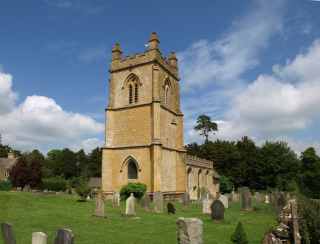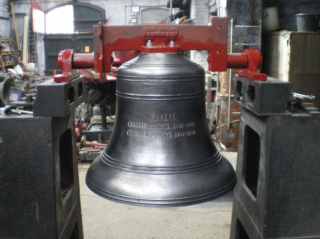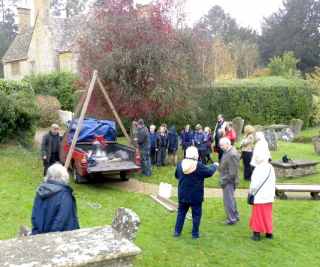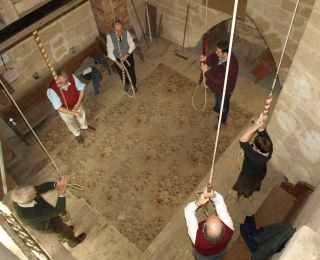It all started in December 2004 with a request to me to inspect Temple Guiting's bells. The PCC wanted them rung for a special Service in late January, but were unsure about the condition of the bells. I looked over them with Peter Forshaw, one of the Churchwardens, who had learnt the rudiments of ringing when Pat Linsdell (past FSG Secretary) was ringing there. I was surprised to find the installation was a full-blown modern Taylor one, with all-metal frame and fittings, and astonished to find the bells hung in a bellframe for 6 bells. There was a spare pit, just waiting for a treble...

The bells weren't in the best of condition. The installation had been neglected, leaving a cracked stay, a loose clapper assembly and ropes in a pitiful and unusable condition. The Service at which the bells were to be rung was less than 3 weeks away, and getting a bellhanger to sort the problems in time was likely to be difficult, so I made a new stay and removed and refitted the clapper assembly. Some second-hand ropes were hastily cobbled into a usable stop-gap condition and I settled down to write my report (undertaken on behalf of the G&B). I mentioned the high quality installation the church possessed, the state of the bells arising from the lack of maintenance — and the fact that there was a spare pit, which clearly was to contain a new treble bell. I said 5-bell ringing was good, but 6-bell ringing was better. No bellframe work was necessary: just open up two trap doors to give an unobstructed lift and plonk a bell in the hole. Yeah, that simple!
It's fair to say nothing grew from that little seed, or that I knew of, but when I was asked to go back to undertake another report on the bells in June 2009 I mentioned the spare pit and a new bell to Avril Vincent this time, the other Churchwarden, who told she had wondered about providing one in memory of her son who had died in 2004, but was unable to bear the cost of doing so. I said a second-hand bell might be available to reduce the cost.
Shortly after this conversation with Avril I was scanning the Keltek Trust lists of redundant bells for re-use, just in case there was a suitable bell, and noticed a Taylor bell apparently the perfect size, weight and, very amazingly, just about the right note for Temple Guiting's new treble. The trebles of what are now the back 5 are fairly large for their note, so a new treble had to be similar. A Taylor bell of the same era (1870) may have been similar, but the bell I noticed was cast in 1967 and therefore of very high quality. So why was it unusually big and heavy?
Further enquiries revealed it had been in the ring of 10 at Prittlewell, Essex. Taylors had won the job to rehang that ring in 1967, but had to recast the 4th bell. The ring and therefore the bell were becoming redundant in mid 2010, when a new ring of bells was to be cast. The old bells were a grotty bunch, mostly cast by Mears in Victorian times. The 4th was the only jewel. I learnt, however, that the bell had already been 'bagged' by a Maltese man, who wanted to export it and some others to Malta for a bell project. Regardless of the Maltese offer to take the bell when it became available, I discussed its suitability for Temple Guiting with Andrew Higson, Taylors' bellmaster, who replied it would be a perfect fit. Hmm, shame about the Maltese offer, but any chance of wresting it away was negated by the estimated overall cost of an augmentation with even a second-hand bell being still outside Avril's reach.
This remained the situation until May 2010, when, after the CCCBR meeting in Derby, a chance conversation with David Kelly of the Keltek Trust included him saying, just as I was departing, that 'Someone wants to give a bell to Temple Guiting'. What?! Please tell me more. Dave told me Peter Newing wished to give the same bell I had noticed. It seems he'd noticed it entirely independently. I told Dave I would contact Peter to find out what he was thinking.
I probably contacted Peter the next day. He told me he'd known of the vacant pit at Temple Guiting for some years and that he felt — in what must be famous words — 'it would be extremely negligent to leave it unfilled' (hah! clerics are such excellent wordsmiths....!). He was willing to purchase the bell, but first the Maltese offer had to be investigated. He asked whether I would act as the project manager if the augmentation went ahead. I was happy to agree.
In July I attended a meeting at Loughborough Bell Foundry. Afterwards I discussed Temple Guiting with some of the staff there, who were on hand to show us round the foundry and tell us how the new John Taylor & Co were to progress after taking over the debris of the old Taylor, Eayre & Smith Co. My discussions were very fruitful. Simon Adams was especially helpful, and Peter Hayward, the new MD, was happy to give me a copy of the original Taylor drawing of December 1970 for Temple Guiting. This drawing revealed a great deal. It showed a new treble was virtually part of the order to rehang the bells, as the new bell was shown in broken lines and its design diameter was 28ins. The treble of the 5 (now the 2nd of 6) is 31.5ins, so the Prittlewell bell, at 29ins, was even better suited. It was a once-in-a-lifetime opportunity. We had to get it!
There were two aspects to investigate: firstly whether St Mary's Temple Guiting PCC were happy to accept the bell if it became available, with the money required to hang it being found locally or through grants; and secondly whether the Maltese bid could be overcome. The Keltek Trust offered other bells in case the Maltese bid couldn't be overcome, but I rejected them because they weren't Taylor bells. There didn't seem any sense at all in mixing founders.
The PCC were grateful, and were very happy to accept the bell, but the extra money required could not come out of their income as they have difficulty paying their quota. It was explained that a grant was expected to be available from the Glos & Bristol Diocesan Association and possibly from the FSG. These, together with donations available from within the parish (another family wished to contribute as a memorial to their son/grandson who had died aged only 4), made them more confident about raising the sum and they formally agreed to go ahead with installing the bell.
The Maltese situation was helped by it becoming known that the bell and two others from the Prittlewell ring were intended for a clock chime. What! A superb Taylor bell in a clock chime when it could be ringing full-circle in a 100% Taylor installation that cried out for it! I suggested to Dave Kelly, somewhat tongue-in-cheek, that the old Prittlewell 3rd could be substituted, as, being only a semi-tone sharp of the 4th, it would happily tune down by that much to give the correct note. All the three bells in the chime would then be by the same founder. Dave put this possibility to Ken Cauchi, the Maltese person (who was acting for a Maltese Government initiative). By great fortune, Ken is a long-time lover of bells - Taylor bells in particular - and he knows all about English-style ringing. This experience allowed Ken to recognise the importance of the Taylor bell to theTemple Guiting project and to his eternal credit he was prepared to cede the bell, but only if the cost of retuning the Prittlewell 3rd was paid for by us. Peter Newing agreed to this extra cost and the Taylor bell became ours.
The first job in the new project was to obtain quotations for the foundry work (fitting the bell to a new headstock, clapper work and inscription work) and the bellhanging work. The choice of foundry was already made: it had to be Taylors, because they had rehung the bells in 1971 and all 5 bells were cast by them. While Whitechapel would also have done a superb job, the bell with their fittings would have stuck out like a sore thumb. Luckily Taylors' price fitted the estimate. This was helped by no retuning costs, as Andrew Higson said, '...it would be an extravagance to re-tune this bell'.
There was a choice of bellhanger: the local firms are Arthur (Bill) Berry and Whites of Appleton. (Who needs to go for other than our local, evercheerful, warm-hearted bellhangers, who speak the same language and operate the same way as we do?). Both companies are capable of excellent workmanship, but in the end I chose Arthur to be the first to quote, only because he has worked very closely with Taylors over very many years. His price fitted the estimate, too, so we signed him up.
The next step was to obtain grants from the likely sources. An application to the G&B was hastily compiled and submitted, just in time for their September Management Committee meeting. The project was lucky; it was offered a very good grant. The Guild had plans to launch a Bell Restoration Fund, but this could not start until voted on at the 2010 AGM - and then the proposal might be voted out. I worked on the basis it would be voted in and therefore had an application ready and waiting for the time the vote gave the green light. It did, I submitted, and the December Committee meeting considered the application and offered the generous sum of £500.

The next stage was a petition for a diocesan faculty to undertake the work. This required inputs from the Diocesan Bells Advisor, Alan Strickland, and, in this case, English Heritage. Luckily the structure would be unaffected and EH gave it a 'no comment' nod. The faculty came through quickly, with only one rider: to obtain the DAC's approval for the inscription.
The cost of incising the inscription rose substantially due to increases by Taylors' subcontractor. A shorter inscription was eventually agreed and DAC approval followed. Both people remembered on the bell shared the name Charlie, so, in addition to their names, the inscription included the bell's name, too: 'Charlie'. By June sufficient finance was in place to allow the PCC to order the work from Berry & Co, with Taylors as the foundry work subcontractor. Another significant moment!
From then on it was largely waiting for things to happen. The Dedication Service was agreed to be part of the Parish Choral Evensong on Sunday November 20th - so everything had to be completed by then! The foundry work included fitting the bell to a new headstock with bearings, and providing a complete clapper assembly. After the new inscription was incised on, the bell returned to have its new wheel fitted and its swing and clapper times checked. Then it was graphite-blacked. Simon Adams took a photo of it on the famous ringing-up stand for me, and here it is. Smart, eh?

'Bill' Berry brought the bell to the Church on Monday 7th November. The relevant people had been alerted, so there was a crowd to welcome it, including children from the Junior School. The two contributing families had their first view of the bell and its inscription and were delighted with what they saw. By the end of that day the bell had been hauled up to the belfry and was sitting in its pit with the wheel attached. It looked entirely happy to be sittinsitting there, in full Taylor surroundings along with its much older siblings.
Some parts had to be made-to-measure, so 'Bill' and Roger returned the following Friday to complete the work. It's surprising how long the fiddly-bits take to do, but 'Bill' and Roger did a superb job. The rope was attached and the bell rung up. It sounded good and it rang well; but what would it be like with the others? A try-out band was booked to come next morning. I hoped the somewhat ponderous nature of the 5 would be overcome by having the extra bell among them, as the 5 had been given swing times of the back 5 of the proposed 6. Would the theory work? Yes, it did! They had morphed into a 6 that felt like a proper 6. And what about sound? The new bell fits in outstandingly well. What an excellent result! Bill Nash inspected the work on behalf of the Guild's Bell Restoration Fund. It was acceptable and therefore the grant could be paid to the project.

The well-attended Dedication Service was a delightful 'village' event: warm, friendly, and a comfortable balance between the formal and the informal. The Guild and the G&B were represented, as were Taylors. Bellhangers 'Bill' Berry and Roger Hunt were there, too. The DAC Bells Advisor Alan Strickland and his wife attended. The Dedication itself was undertaken by both the Rev Veronica James, Rector of St Mary's, and the Rev Peter Newing, after which all 6 bells were rung by a band representing the Guild, the G&B, Taylors, Berry & Co, the local Benefice ringers and myself as project manager. Veronica took time during the Service to thank everyone involved with the project, at which time the grant cheques from the G&B and the Guild were handed to the PCC. Alan Berry, for Taylors, handed over a copy of the 'works' drawing of the installation for the PCC's records.
Tea, coffee and cakes were available after the Service, at which time, too, there was open ringing on the bells. It was a big surprise to find David Sloman, Prittlewell's Ringing Master, and his wife were there, particularly as it was a long way to come on such a foggy day. David rang the bell and thought it sounded well among the others and that it was now very appropriately accommodated - far better than ever it was at Prittlewell!
The Dedication was a very happy end to a very successful project.
For those who like such things, here are the details of the bells:-
| Bell | Weight | Note | Dia | Founder | Cast |
|---|---|---|---|---|---|
| Treble | 5-2-7 | D# | 29" | J Taylor & Co | 1967 |
| 2nd | 5-2-11 | C# | 31.5" | J Taylor & Co | 1871 |
| 3rd | 5-3-17 | C | 32.5" | J Taylor & Co | 1870 |
| 4th | 6-3-27 | A# | 33.5" | J Taylor & Co | 1905 |
| 5th | 8-0-5 | G# | 36.75" | J Taylor & Co | 1870 |
| Tenor | 11-3-17 | F# | 41.75" | J Taylor & Co | 1870 |
Although the old inscription was taken off the treble, erasing its Prittlewell identity, I noticed as it was being hauled up that 'Prittlewell 4th 2'-5"' was chalked inside it. This was probably done when it was cast. It will be left on.
There is a chance to try out the 6 at the Guild practice on March 17th.
Chris Povey